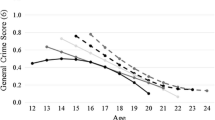Abstract
Household survey data on age at first use of alcohol, tobacco, marijuana,and hard drugs can be biased due to sample selection and inaccuraterecall. One potential concern is attrition, whereby individuals who getinvolved with substance use at an early age become increasingly less likelyto be surveyed in successive years. A comparison of data from the NationalHousehold Survey on Drug Abuse (NHSDA) with data from a longitudinal studysuggested that attrition might have caused substantially less bias thandid “forward telescoping,” the inflating of age at first useover time. The evidence of forward telescoping was particularly pronouncedwith respect to age at first use of alcohol. This paper presents a procedurefor correcting the distribution of age at first use for forward telescoping(but not attrition) by viewing a portion of the NHSDA data collected insuccessive years as constituting a cohort study. Results are presented fromapplying this procedure with NHSDA data collected from 1982 to 1995 forrespondents born 1968–1973. The findings suggest that preventionprograms need to be introduced at an earlier age than would be indicatedby “uncorrected” retrospective data. Other implications are alsohighlighted.
Similar content being viewed by others
REFERENCES
Bailey, S. L., Flewelling, R. L., and Rachal, J. V. (1992). The characterization of inconsistencies in self-reports of alcohol and marijuana use in a longitudinal study of adolescent. J. Stud. Alc. 53: 636–647.
Biemer, P. P., and Witt, M. (1997). Repeated measures estimation of measurement bias for selfreported drug use with applications to the National Household Survey on Drug Abuse. In Harrison, L., and Hughes, A. (eds.), Validity of Self-Reported Drug Use: Improving the Accuracy of Survey Estimates, NIDA Research Monograph 167, NIH Publication No. 97-4147, pp. 439–476.
Brewer, W. F. (1988). Memory for randomly sampled autobiographical events. In Neisser, U., and Winograd, E. (eds.), Remembering Reconsidered: Ecological and Traditional Approaches to the Study of Memory, Cambridge, New York, pp. 21–90.
Eisenhower, D., Mathiowetz, N. A., and Morganstein, D. (1991). Recall error: sources and bias reduction techniques. In Biemer, P. P., Groves, R. M., Lyberg, L. E., Mathiowetz, N. A., and Sudman, S. (eds.), Measurement Errors in Surveys, Wiley, New York, pp. 127–144.
Elliott, D. S. (1992). Longitudinal research in criminology. Promise and practice (unpublished manuscript).
Fendrich, M., and Vaughn, C. M. (1994). Diminished lifetime substance use over time: An inquiry into differential underreporting. Public Opin. Q. 58: 96–123.
Funkhouser, J. E., Goplerud, E. N., and Bass, R. O. (1992). The current status of prevention strategies. In Jansen, M. A. (ed.), A Promising Future: Alcohol and Other Drug Problem Prevention Services Improvement, OSAP Prevention Monograph No. 10, DHHS Publication No. (ADM) 92-1807, Government Printing Office, Washington, DC, pp. 17–82.
General Accounting Office (GAO) (1993). Drug Use Measurement: Strengths, Limitations and Recommendations for Improvement, GAOyPEMD-93-18.
Golub, A. L., and Johnson, B. D. (to appear). Substance use progression and hard drug abuse in inner-city New York. In Kandel, D. B. (ed.), Stages and Pathways of Involvement in Drug Use: Examining the Gateway Hypothesis, New York: Cambridge (accepted for publication).
Golub, A. L., Labouvie, E., and Johnson, B. D. (2000). Response reliability and the study of adolescent substance use progression. J. Drug Issues 30: 103–118.
Grant, B. F. (1998). Age at smoking onset and its association with alcohol consumption and dependence: Results from the National Longitudinal Alcohol Epidemiologic Survey. J. Substance Abuse 10: 59–73.
Grant, B. F., and Dawson, D. A. (1997). Age at onset to alcohol use and its association with DSM-IV alcohol abuse and dependence: Results from the National Longitudinal Alcohol Epidemiologic Survey. J. Substance Abuse 9: 103–110.
Hanson, D. J. (1996). Alcohol Education: What We Must Do, Praeger, Westport, CT.
Harrison, L. (1995). The validity of self-reported data on drug use. J. Drug Issues 25: 91–111.
Hawkins, B., Catalano, R. P., and Miller, J. Y. (1992). Risk and protective factors for alcohol and other drug problems in adolescence and early adulthood: Implications for substance abuse prevention. Psychol. Bull. 112: 64–105.
Horwitz, A. V., and White, H. R. (1987). Gender role orientation and styles of pathology among adolescents. J. Health Soc. Behav. 28: 158–170.
Johnson, R. A., Gerstein, D. R., and Rasinski, K. A. (1997). Recall decay and telescoping in self-reports of alcohol and marijuana use: Results from the National Household Survey on Drug Abuse [NHSDA]. In Proc. Am. Assoc. Pub. Opin. Research.
Johnston, L. D., and O'Malley, P. M. (1997). The recanting of earlier reported drug use by young adults. In Harrison, L., and Hughes, A. (eds.), Validity of Self-Reported Drug Use: Improving the Accuracy of Survey Estimates, NIDA Research Monograph 167, NIH Publication No. 97-4147, pp. 59–80.
Kandel, D. B. (1978). Convergence in prospective longitudinal surveys of drug use in normal populations. In Kandel, D. B. (ed.), Longitudinal Research on Drug Use: Empirical Findings and Methodological Issues, Hemisphere, Washington, DC, pp. 3–38.
Labouvie, E., Bates, M. E., and Pandina, R. J. (1997). Age of first use: Its reliability and predictive utility. J. Stud. Alc. 58: 638–643.
Mills, C. J., and Noyes, H. L. (1984). Patterns and correlates of initial and subsequent drug use among adolescents. J. Consult. Clin. Psychol. 52(2): 231–243.
Substance Abuse and Mental Health Services Administration (SAMHSA) (1997). National Household Survey on Drug Abuse: Population Estimates 1996, Department of Health and Human Services Publications No. (SMA) 97–3137.
Tonry, M., Ohlin, L. E., and Farrington, D. P. (1991). Human Development and Criminal Behavior: New Ways of Advancing Knowledge, Springer-Verlag, New York.
Wright, D., Gfroerer, J., and Epstein, J. (1997). The use of external data sources and ratio estimation to improve estimates of hardcore drug use from the NHSDA. In Harrison, L., and Hughes, A. (eds.), Validity of Self-Reported Drug Use: Improving the Accuracy of Survey Estimates, NIDA Research Monograph 167, NIH Publication No. 97-4147, pp. 447–497.
Author information
Authors and Affiliations
Rights and permissions
About this article
Cite this article
Golub, A., Johnson, B.D. & Labouvie, E. On Correcting Biases in Self-Reports of Age at First Substance Use with Repeated Cross-Section Analysis. Journal of Quantitative Criminology 16, 45–68 (2000). https://doi.org/10.1023/A:1007573411129
Issue Date:
DOI: https://doi.org/10.1023/A:1007573411129




